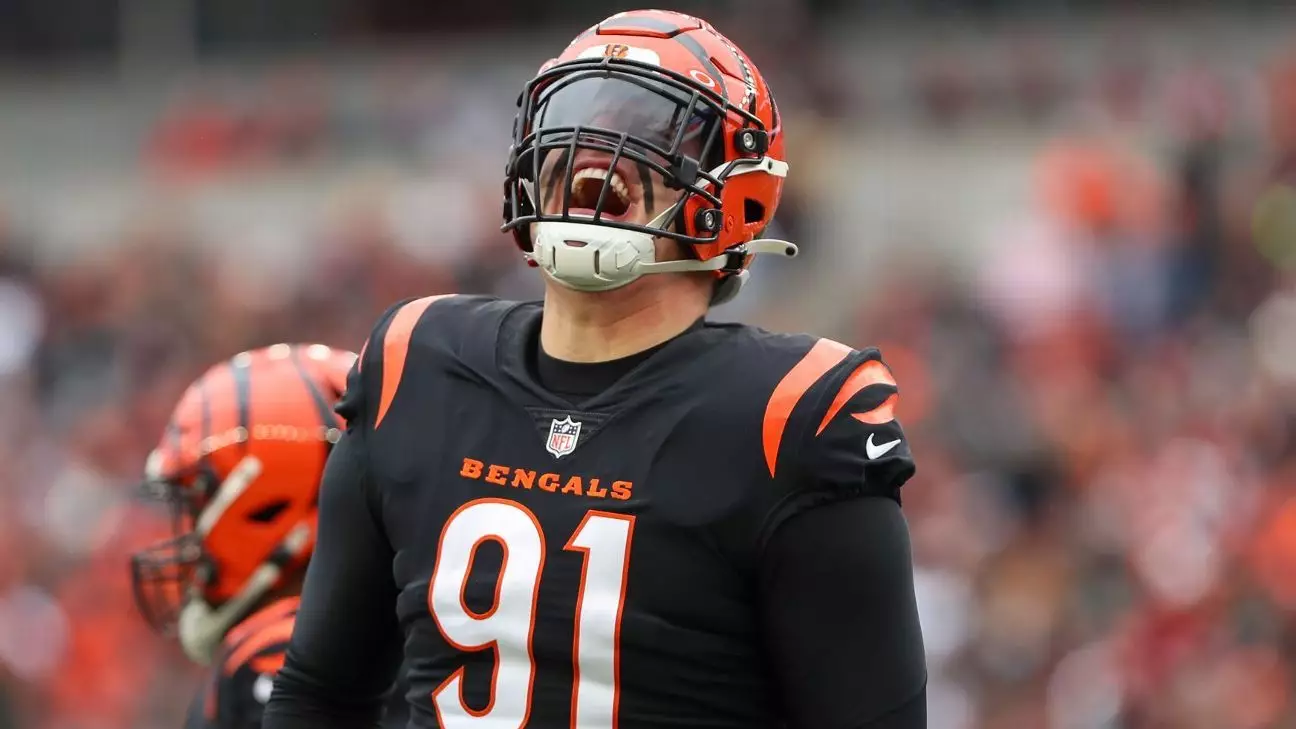A Bold Stand: Trey Hendrickson’s Contract Saga and Its Implications for the Bengals
In the world of professional sports, contract negotiations can often feel like a game within a game. Recently, Trey Hendrickson, a star defensive end for the Cincinnati Bengals, found himself at the center of such a saga. It all started when he took a public stance regarding the stalled negotiations for his contract extension. Following the NFL draft, he announced that communications between his representatives and the Bengals had ceased. This left him in disbelief over what he perceives as a lack of ambition from the organization.
Hendrickson’s situation has become increasingly perplexing, signaling a shift away from the collaborative spirit ideally associated with such negotiations. His assertion that he has been left in the dark highlights a critical gap between player expectations and team strategy. In an environment where NFL contracts serve as both a measure of worth and a reflection of a player’s viability within a franchise, this breakdown in dialogue amplifies not only personal uncertainty but also raises broader questions about the Bengals’ approach to talent management.
Key Takeaways
- Trey Hendrickson’s contract situation highlights challenges in player-team communication.
- The breakdown in negotiations may affect team morale and performance.
- Effective dialogue and tailored approaches are essential for resolving such disputes.
A Star at Risk of Dimmed Potential
At 30 years old, Trey Hendrickson’s career is at a pivotal juncture. He’s coming off a career-best season in which he led the NFL with 17.5 sacks and earned an All-Pro designation. Expectations for him could not be higher. However, as he enters the final year of his four-year, $60 million deal, uncertainty looms large over his impressive on-field accomplishments. In a league that often emphasizes reward for performance, it becomes increasingly troubling when a star player feels undervalued amidst organizational decisions.
While Hendrickson awaits clarity, it’s important to remember that contract talks often reveal deeper issues within team culture and player relationships. An anecdote from Bengals executive Katie Blackburn downplaying Hendrickson’s concerns only adds to the unsettling atmosphere. Her statement suggesting that Hendrickson might be content at “certain rates” exemplifies a concerning disconnect, potentially undermining player morale and echoing sentiments that the organization may not effectively prioritize talent retention or player satisfaction.
The Impact on Team Dynamics
The Bengals find themselves in a delicate balancing act: managing their financial commitments while maintaining healthy player relationships. Having secured an impressive contract for Ja’Marr Chase, they now face significant dilemmas concerning Hendrickson’s future. His public disappointment serves as a cautionary tale for the franchise—a reminder that contracts are more than financial documents; they are emotional agreements between players and management.
As the Bengals gear up for a new season, pressure mounts to resolve this issue. Not only is Hendrickson one of the cornerstones of the Bengals’ defense, but he also embodies a culture of accountability and performance. Allowing this contract saga to culminate in unresolved tension could lead to undesirable fractures within the locker room, dramatically affecting both performance and morale.
Moreover, this predicament stretches beyond just Hendrickson. Another defensive end, Shemar Stewart, remains unsigned, pointing to potentially larger trends of contract disputes that could hinder team preparations ahead of organized activities. The deadlock over Hendrickson’s deal cannot be viewed in isolation; its repercussions may echo across the roster, sowing dissatisfaction and fostering an atmosphere where talent feels disrespected.
Potential Solutions and the Road Ahead
The current impasse calls for resolution rooted in open and honest dialogue. Communication must pivot from being one-sided to becoming a collaborative conversation where concerns from both sides are heard and respected. Hendrickson is not merely seeking validation; he’s advocating for recognition that his contributions deserve more than baseline negotiation terms. The Bengals must acknowledge that each player’s journey is unique and sometimes warrants tailored approaches rather than adherence to rigid metrics and salary slots.
As the organization prepares for crucial team activities, management must recognize the importance of preserving relationships while being strategic in business decisions. Successfully navigating this storm will not only secure a key player’s commitment but also reinforce a culture of respect extending beyond negotiating tables. Ultimately, fostering an environment where players feel genuinely valued could lead to better performance—and ultimately—a more competitive team come game day.
Final Thoughts
The saga surrounding Trey Hendrickson’s contract negotiations offers valuable insights into the complexities of player-team dynamics in professional sports. It underscores the need for effective communication and genuine recognition of contributions beyond mere statistics or financial figures. As fans eagerly await resolutions, it remains clear that how these situations are handled can significantly impact both immediate performance outcomes and long-term organizational culture within franchises like the Bengals.
Trey Hendrickson
Cincinnati Bengals
NFL contracts
team dynamics


Leave a Reply